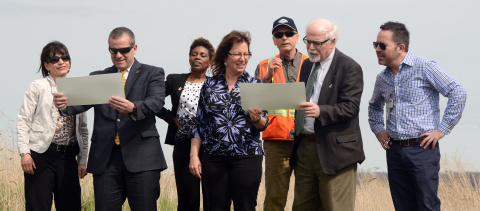| Observing the remedial and ecological changes from atop the Fernald Preserve On-Site Disposal Facility (from left to right) Yvonne Deyo (Navarro), Jonathan Graebener (U.S. Army Interagency Fellow), Tania Smith Taylor (DOE LM), Gwen Hooten (DOE LM), Bill Hertel (Navarro), David Klaus (DOE Deputy Under Secretary), and Bud Sokolovich (DOE LM). |
On March 30, 2016, David M. Klaus, the Deputy Under Secretary for Management and Performance at the U.S. Department of Energy (DOE), traveled to the Fernald Preserve in southwest Ohio. The Office of the Under Secretary for Management and Performance has responsibility for the Department’s primary mission support functions (i.e., management, procurement, human capital, information technology, safety and health, and project management) and two program offices (the Office of Environmental Management and the Office of Legacy Management [LM]). Mr. Klaus was joined by a member of his staff, Jonathan Graebener.
To start the visit, Mr. Klaus was given a briefing about the history of the Fernald site. The briefing included the uranium processing work from the early 1950s through the present-day LM mission of managing the land, contractor retiree benefits, and records, and maintaining the site’s environmental remedies.
Following the briefing, Mr. Klaus was provided a tour of the Visitors Center exhibits. The tour included a discussion about the Center’s role in building community connections and the facility’s Leadership in Energy and Environmental Design, or LEED-Certified Platinum design features. Next, the group hiked to the top of the On-Site Disposal Facility (OSDF) for a discussion of the structure’s protective features and its’ performance. The top of the OSDF provided a panoramic view of the 170-acre, restored former production and waste storage areas, and a discussion of the site’s ecological restoration and maintenance activities.
The driving portion of Mr. Klaus’ site tour included viewing the results of a recent 25-acre prescribed burn on one-third of the OSDF cap, the wetlands areas created during cleanup, and the restored prairie grass communities.
The tour’s final stop was the site’s water treatment plant where Mr. Klaus was given an overview of the Preserve’s aquifer restoration efforts and a briefing on the operations and maintenance challenges associated with a large-scale groundwater remediation project. Tania Smith Taylor said,“It was great to have Mr. Klaus visit the Fernald Preserve to see what we are doing at one of LM’s major sites.”


